Every autumn, the harvest comes in and the trees shed their leaves, at least in temperate climates. During these times, we see some reflection on the role of religion and superstition in society. The transition from summer to winter is seen as a liminal time, one of heightened spiritual activity, with no days more liminal than All Hallow’s Eve through All Soul’s Day.
Publications like The Atlantic and The New York Times have in the past run myriad articles in October and November talking about the history of witchcraft and its seeming rise in recent years—drawing parallels or dichotomies between historical witch hunts and the modern political invocation of the term. Social media is replete with memes alleging in exaggerated ways the mysterious and pagan origins of Halloween. While the American sense of Halloween’s ancient origins is usually at least a little mistaken (Religion for Breakfast goes over the nuances here), what can’t be denied is the feeling of tension in so many communities between the literal and figurative light and dark.
In many ways, Magic has succeeded masterfully at representing this tension, especially in its “horror” themed sets: The Dark, and every set on the plane of Innistrad. However, as I began to suggest earlier this month—if this summer’s events didn’t make it abundantly clear—representation can be good or bad.
Mark Rosewater and others made the case that in very real ways, with its planar travel and hard magic system, Magic is most akin to science-fiction—which asks “what is possible?”—despite being dressed up in the trappings of fantasy—which asks “will good win over evil?” These aren’t unrelated: our dreams of possibility often reveal our aspirations for a future that is more just, or a pessimism that it will not be.
We can and should ask what kinds of values statements the story and the cards of The Dark, Innistrad, and Eldritch Moon make. In their representation of moral struggle, what injustice do these sets challenge, and what might they reinscribe?
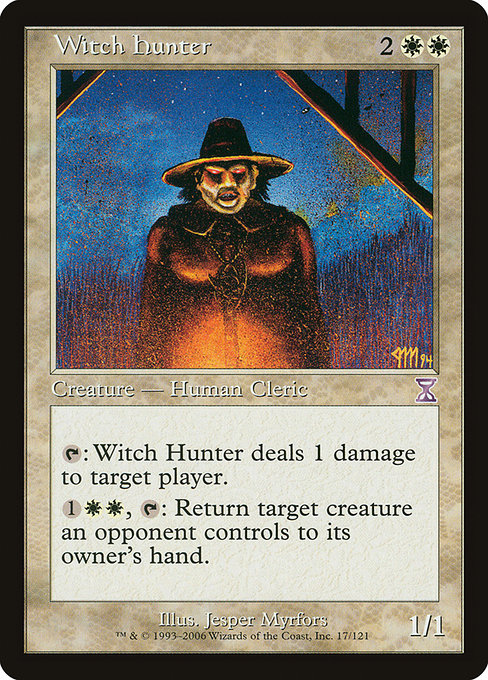
The Dark Side of Religion
The Dark is a set that is about subversion. Jesper Myrfors has said that with this set, he intended to counter problems arising with certain cards at the time and decrease overall power level. Additionally, he designed cards that made use of friendships between enemy colors, broke the color pie, and featured a uniform art style according to his own preference for horror.
The Dark also subverted Magic’s initial representation of what white magic was. Myrfors has said that he wanted to push back on early Magic’s seeming identification of white with goodness: “It was a set in which I wanted to show that White was not all kisses and flowers, that White could descend into theocracy and fascism.”
In an interview with Hipsters in 2015, Jesper Myrfors told us that The Dark “was a commentary on the evils of organized religion,” adding elsewhere that it was “about religious intolerance, which is a theme I return to often. It was the horror of puritanical America.” While the terrifying and uncanny nature of black remained, and is seen in full force on cards such as Rag Man and The Fallen, one of the scariest things about the fictive world of The Dark is that there is nowhere to run. Rather than the welcoming Northern Paladin or the aspirational Swords to Plowshares, the white cards of the Dark greet us with an Angry Mob, a clergyman preaching Fire and Brimstone, and cards such as Martyr’s Cry and Blood of the Martyr—revealing that not only is white lashing out at other colors for their impurity, but also turning upon itself.
Jeff Grubb’s novelization The Gathering Dark doubles down on this characterization. In his telling, The Church of Tal, an increasingly anti-magic religion, grows in power as the populace seeks a means of making sense of the destruction wrought by the Brothers’ War. Out of a fear of history repeating itself, the Church eventually establishes a theocratic rule that heavily persecutes spellcasters, ultimately going on “witch hunts” to find and execute magic-users and artificers. Already, the art direction of The Dark evoked real-world witch trials and used Christian symbolism; Grubb borrows Christian scripture to make the “thin metaphor” even thinner, placing an infamous passage from the book of Exodus on the lips of the Preacher: “‘Suffer not the Magician to live’” (p. 261).
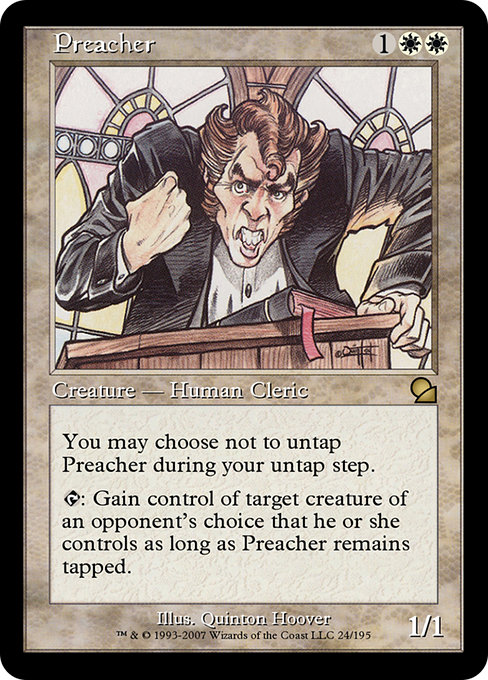
Still in the Season of the Witch
This wouldn’t be the last time that a twisted religion would show up in the Magic narrative, but it is in some ways the most terrifying because it hit closest to home. In the West, the moral panics over witchcraft reached a fever pitch in the mid-15th century, lasted over 300 years and claimed over 50,000 lives, with an estimated 80% of those being women’s lives. In recent years, the dramaticization of Margaret Atwood’s The Handmaid’s Tale for Hulu has combined with religious political rhetoric to bring the cultural memory of anti-feminist persecution back to our minds.
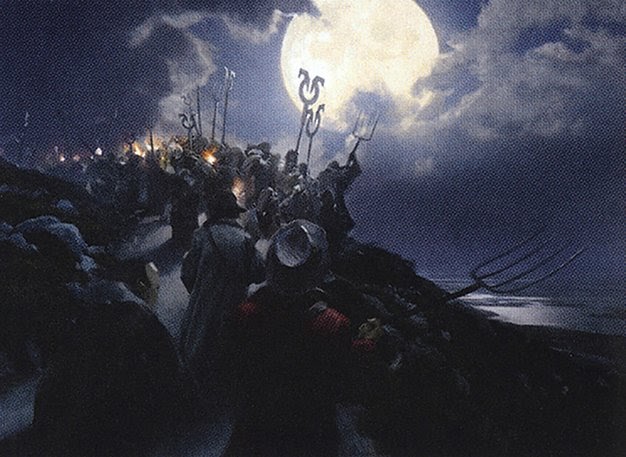
“Rally the Peasants” by Jaime Jones
Christian communities indeed continue to reckon with their own history of patriarchy and their role in historical—and globally speaking, contemporary—witch hunts. Inasmuch as Christian hegemony still persists despite flagging moral authority, in recent decades, the title of “witch” has been the subject of something of a reclamation in the U.S. Like the term “nasty woman,” the intent was once to stigmatize—often a death sentence for women who did not fit neatly into prescribed societal roles.
“Witch” has now been claimed as a mantle of rebellion, both metaphorically and literally: interest in and practice of witchcraft is on the rise. As others, such as Shivam Bhatt and Kelly Digges, have noted, Magic has often taken a critical tone when it comes to representations of religious belief (though this has recently begun to change with Dominaria and the creation of Basri Ket). However, the representation of witchcraft as one of those religious impulses is something to which we should likely give more thought.
The contemporary representations of witches stem from those ancient accusations—the witch was either harlot or hag. She forced a conflict with the agency of women in her excesses and in her non-conformity to the approved place of women in society. She was either too sexual, or unable to be objectified; so knowledgeable and canny that men had to label her uncanny and insane; so self-possessed that she needed to be condemned as demon-possessed.
Stories didn’t merely allege that witches fell outside of women’s place in society, but represented its undoing. The witch was anti-maternal: cursing other women with barrenness, afflicting children with magical maladies, or even stealing and eating those little ones who ventured into the woods. Of course, in many cases, many of the accused suffered for being easy targets, in the wrong places at the wrong times; nevertheless, the above litany of traits persist in the modern characterization of witches.
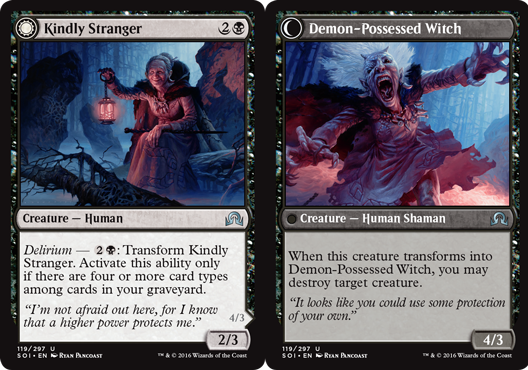
For being so comfortable criticizing the evils of the religions that persecuted them, Magic seems to be of two minds about whether to critique the characterization of the witch or lean into it. It tells us that a Witch Hunt is an act of violence, while simultaneously affirming that witches are dangerous, mostly black-aligned mages that hex and curse—everything the hunters accuse them of being. Yet Magic: the Gathering isn’t much different than society at large, here.
American society is currently in a strange place regarding witches. Pam Grossman, author of Waking the Witch, wrote in the New York Times, being a witch today can be complicated:
“Like many such epithets, the word ‘witch’ is loaded and coded. I’m thoughtful about how I use it because it is a word that carries weight, even as it liberates. Whether we’re speaking of literal witch hunts or metaphorical smears (just Google any female politician’s name alongside the word ‘witch’ and you’ll see what I mean), it is a word that has been linked to centuries of misogyny and oppression.”
According to Grossman, the adoption of the terrifying name—like putting on a costume, or a Halloween mask—diminishes its power over us; while we might have feared its clutches, it is now in our hands. To own the language is to challenge and subvert its negative associations, to provide a counter-witness, and to turn the fear that motivates it back against the persecutor.
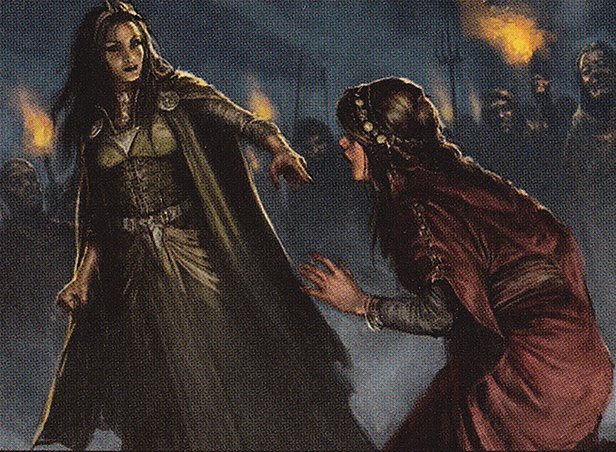
“Witch Hunt” by Karl Kopinski
In Western countries, depictions of witches abound in ancient books like the Bible, the Malleus Maleficarum, and The Discoverie of Witchcraft; and in pop culture, as in film and television series such as The Wizard of Oz and Sabrina; and in games like Magic: the Gathering. Perhaps they no longer incite us to take up literal torches; nevertheless these tropes still shape how we talk about practitioners of pagan spirituality, and more broadly how we view women in society.
Whereas one might argue that Magic’s critique of organized religion—especially inasmuch as it critiques Christian hegemony—is punching up, I’m less certain that we can begin to argue that stereotypical depictions of witches in Magic are at all helpful. A 2018 article entitled “Witchcraft Accusations as Gendered Persecution in Refugee Law,” by Sara Dehm and Jenni Millbank, notes that refugees fleeing witchcraft-related violence are an “increasing concern for international human rights and aid organizations through much of the current century”; and that even now, accusations of witchcraft against men and women can be deadly in places like Papua New Guinea, Nepal, Tanzania, and Nigeria.
In sum, Magic’s long standing use of organized religion characterized as a witch-hunting theocracy works as a horror trope because it reminds us of our own cultures’ checkered histories and challenges us to make our way in a gothic fantasy world where forces of light are either vastly outnumbered or nigh indistinguishable from the evils that lurk in the dark. However, these implicit critiques often simultaneously re-inscribe anti-pagan and anti-feminist depictions that the source material for Magic’s in-game religious fanatics established as tropes in the first place. Magic’s most recent witches traipse through bogs, luring children to their doom with the offering of tainted apples (Tempting Witch), possessing multiple arms (Witch of the Moors) or covering themselves in rats (Chittering Witch).
It isn’t inherently wrong to make use of horror tropes—we all understand that this is a fictional game world. But neither is it off-limits to question the ways in which these tropes do or do not help us to build a more equitable world; to push not merely for liberating “reclamations,” but even new ways of subverting formerly pernicious stereotypes.
Recommended Media:
Anne Llewellyn Barstow, “On Studying Witchcraft as Women’s History: A Historiography of the European Witch Persecutions,” in Journal of Feminist Studies in Religion Vol. 4, No. 2 (Fall, 1988): 7-19.
Pam Grossman, Waking the Witch: Reflections on Women, Magic, and Power (New York: Gallery Books, 2019).
Jeff Grubb, The Gathering Dark (Wizards of the Coast, 1999).
Laura M. Holson, “Witches are Having their Hour,” The New York Times, Oct 11, 2019.
Matt Jones, “Arting Around—Jesper Myrfors Interview,” Hipsters of the Coast, June 29, 2015.
Rhystic Studies, “1995: The Season of the Witch”
Jacob Torbeck is a researcher and instructor of theology and ethics. He hails from Chicago, IL, and loves playing Commander and pre-modern cubes.

